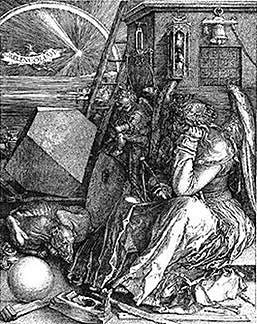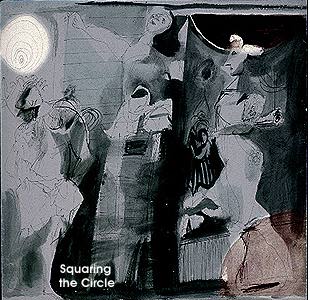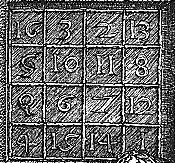|
|
Melencolia |
|
 If you've found this site useful, we'd really appreciate a small donation to help with the hosting costs. Thanks! |
In the year 1514 the German painter and engraver Albrect Dürer made his most famous engraving, 'Melencolia'. The engraving is an allegory describing the creative melancholy of the artist and is thought to be a symbolic self portrait. Dürer's Melencolia is replete with alchemical symbolism related directly to much of the symbolism in the 1934 drawing. Picasso was a great admirer of Dürer and owned at least one original print by the artist, given to him by Max Jacob; he also owned a an expensive German edition of reproductions of Dürer's work.
Dürer's theme of Saturnalian Melancholy appears to have been derived from a treatise by a German physician named Heinrich von Nettesham, written around 1510, and entitled 'De occulta philosophia.' Since classical times artistic Melencolia was thought of as a depressed state of mind that takes away an artist's enthusiasm for his work. It's cure was believed by Renaissance astrologer's to be aided by the charm of a magic square and in particular the Jupiter magic square which appears in the upper right hand corner of Dürer's engraving. The square is magic because each row, each column and each diagonal, add up to the same number, which in the Jupiter magic square is 34. The numerals 3 and 4 also denote special importance in Alchemy because they represent the spiritual transformation of the alchemist. 3 symbolises the limited, finite life of the physical world and everyday existence and 4 symbolises the infinite realm of the spirit and the cosmos. Their product is 12, the number of Tarot card the Hanged Man, which in turn symbolises the union of physical life and spiritual life.
The number 34 is relevant to the drawing because it refers the year it was made and to its predominant theme of Crucifixion because of its association to the symbolism of the Hanged Man in the Tarot.
In a similar way Picasso hid the date of production into the 1934 drawing. The digits '34' appear in many places within the black ink of the composition, but are only made visible after computer enhancement.
The square format of the drawing is rare in Picasso's work, and in this case, it appears to signify that the drawing is itself a magic square, intended to charm off the melancholy that was beginning to affect Picasso's life at the time. The 1934 drawing contains a number of other esoteric elements which appear to have been borrowed from Dürer's Melencolia. In both compositions for example, there is a concealed squaring of a circle. In the lower left corner of Dürer's work there is a circle in the form of a globe, in the upper left corner there is a semi-circle in the form of a rainbow, and in the upper right there is a quarter circle defined by a bell rope and in the lower right corner the circle disappears altogether, thereby breaking the sequence. This is a circle being halved systematically through three corners of the frame of the composition and finally disappearing. In the 1934 drawing, we find the same process taking place. In the upper left corner, there is a circle in the form of the spiral motif, in the upper right corner, there is a semi circle in the form of a black half moon, and in the lower right corner, there is a quarter circle painted in wash, finally in the lower left corner all traces of the circle disappear, again breaking the sequence. The symbolism indicates liberation or transcendence from melancholy and it is also strongly indicative of death and resurrection. The two pictures also contain very similar iconography, in each there is a dog, a ladder, two angels, the tools of the artist's trade: paints and a brush in the Picasso and woodworking tools in the Dürer. All this leaves little doubt that Dürer's greatest engraving was an important source in the creation of the 1934 drawing.
© Mark Harris 1996 Alchemical ContextsNext Section: Interpretations of the 1934 Drawing |
|
|
|
     |
     |
|
|
© Mark Harris 1996 (content), Simon Banton 1996 (design) In general copyright of works by Pablo Picasso are the property of the heirs to the Pablo Picasso estate |
|



 In Melencolia, Dürer has incorporated the engraving's date, 1514, into the lower row of numbers in the magic square.
In Melencolia, Dürer has incorporated the engraving's date, 1514, into the lower row of numbers in the magic square.